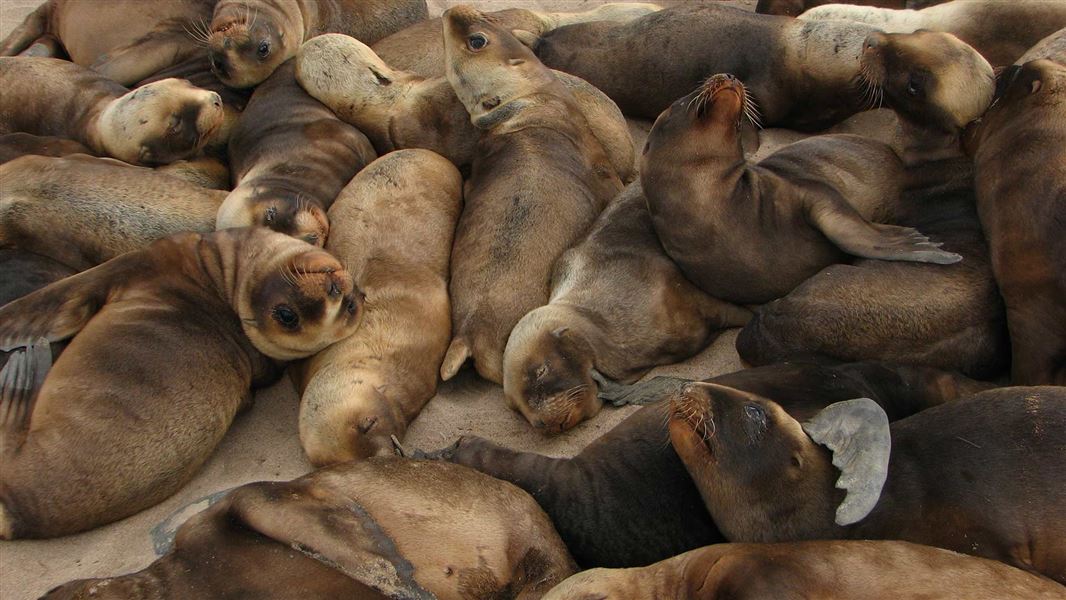About the plan
The New Zealand sea lion Threat Management Plan was published in 2017. It aims to halt the decline of the New Zealand sea lion population within five years and ensure the population is stable or increasing within 20 years. The ultimate goal is to achieve Not Threatened status.
Between 1998 and 2009 the number of sea lion pups born annually at the Auckland Islands declined by 50%. In 2014, the Minister of Conservation and the Minister for Primary Industries asked officials to develop the New Zealand sea lion Threat Management Plan (NZSL TMPs).
The Government is investing $2.8 million over four years on the plan. This includes a liaison officer to help reduce human-induced threats to sea lions on the New Zealand mainland.
New Zealand sea lion Threat Management Plan 2017-2022 (PDF, 2,135K)
Consultation on the Threat Management Plan for New Zealand sea lions
Workstreams of the plan
The threat management plan has four workstreams
- Engagement: Coordinating and implementing an engagement campaign that facilitates a positive and accepted expansion of the range of sea lions.
- Direct mitigation: Actions to reduce the impacts of key threats to sea lions are determined annually.
- Targeted research: To address key threats to sea lions applied research will be determined annually.
- Evaluation: To evaluate progress against the NZSL TMP objectives, monitoring of the sea lion breeding population is required.
Each year, a workplan that ties into these streams will be developed based on the previous year’s work and with input from the newly established New Zealand sea lion Forum and Advisory Group. The principles of mātauranga Māori will be woven throughout all four workstreams to achieve the vision of the Threat Management Plan.
Prioritised workstreams diagram 2017/2018 (PDF, 61K)
Measures of success
The threat management plan has a vision, five year and 20 year objective. These objectives are supported by site-specific measures of success which recognise the differences between the four breeding locations of New Zealand sea lions and the pressures they face.
Site specific measures:
Auckland Islands: pup production continues to increase from the 2014 count
- Adult female survival rate and pup survival rate improve.
- Pup numbers are consistently above 1,575 (2014 pup count) and ideally over 1,965 (2017 pup count).
Campbell Island / Motu Ihupuku: reduce pup mortality and support population growth
- Pup counts are consistently at or above 696 (2015 pup count)
- Pup mortality rates are consistently lower than 40% per annum, and
- Frequency and consistency of monitoring of sea lions has increased.
Stewart Island / Rakiura: support population growth to achieve breeding colony status
- Pup counts remain higher than 35 for 5 years in a row, qualifying this site as a new breeding colony.
- Pup production continues to increase to allow for colonial breeding.
- There are no cases of deliberate human-caused mortality.
- Public involvement in the conservation of sea lions increases.
South Island / Te Waipounamu: support population growth
- Pup counts along this stretch of coastline increase to above 16 per year, eventually reaching 35, on track to achieving breeding colony status.
- There are no cases of deliberate human-caused mortality.
- Public involvement in the conservation of sea lions increases.
Success across the New Zealand sea lion range
- Pup mortality from falling into natural holes is reduced.
- Disease research yields answers to inform recommendations to reduce pup mortality from Klebsiella pneumoniae.
- Estimation of SLED efficacy and cryptic mortality affecting adult female survival improves.
- The effects of climate change and fisheries on sea lion nutritional status are better understood.
- Sea lion breeding sites developing and colonies establishing at new locations.
- The New Zealand sea lion threat status improves from Nationally Critical to Not Threatened.
